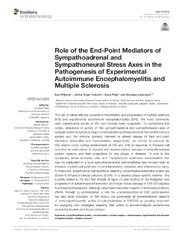Приказ основних података о документу
Role of the End-Point Mediators of Sympathoadrenal and Sympathoneural Stress Axes in the Pathogenesis of Experimental Autoimmune Encephalomyelitis and Multiple Sclerosis
| dc.creator | Pilipović, Iivan | |
| dc.creator | Stojić-Vukanić, Zorica | |
| dc.creator | Prijić, Ivana | |
| dc.creator | Leposavić, Gordana | |
| dc.date.accessioned | 2020-02-13T11:37:25Z | |
| dc.date.available | 2020-02-13T11:37:25Z | |
| dc.date.issued | 2020 | |
| dc.identifier.issn | 1664-2392 | |
| dc.identifier.uri | https://farfar.pharmacy.bg.ac.rs/handle/123456789/3503 | |
| dc.description.abstract | The role of stress effector systems in the initiation and progression of multiple sclerosis (MS) and experimental autoimmune encephalomyelitis (EAE), the most commonly used experimental model of MS, has strongly been suggested. To corroborate this notion, alterations in activity of the sympathoadrenal and sympathoneural axes of sympathoadrenal system (a major communication pathway between the central nervous system and the immune system), mirrored in altered release of their end-point mediators (adrenaline and noradrenaline, respectively), are shown to precede (in MS) and/or occur during development of MS and EAE in response to immune cell activation (in early phase of disease) and disease-related damage of sympathoadrenal system neurons and their projections (in late phase of disease). To add to the complexity, innate immunity cells and T-lymphocytes synthesize noradrenaline that may be implicated in a local autocrine/paracrine self-amplifying feed-forward loop to enhance myeloid-cell synthesis of proinflammatory cytokines and inflammatory injury. Furthermore, experimental manipulations targeting noradrenaline/adrenaline action are shown to influence clinical outcome of EAE, in a disease phase-specific manner. This is partly related to the fact that virtually all types of cells involved in the instigation and progression of autoimmune inflammation and target tissue damage in EAE/MS express functional adrenoceptors. Although catecholamines exert majority of immunomodulatory effects through β2-adrenoceptor, a role for α-adrenoceptors in EAE pathogenesis has also been indicated. In this review, we summarize all aforementioned aspects of immunopathogenetic action of catecholamines in EAE/MS as possibly important for designing new strategies targeting their action to prevent/mitigate autoimmune neuroinflammation and tissue damage. | en |
| dc.publisher | Frontiers Media S.A. | |
| dc.relation | info:eu-repo/grantAgreement/MESTD/Basic Research (BR or ON)/175050/RS// | |
| dc.rights | openAccess | |
| dc.rights.uri | https://creativecommons.org/licenses/by/4.0/ | |
| dc.source | Frontiers in Endocrinology | |
| dc.subject | experimental autoimmune encephalomyelitis | |
| dc.subject | multiple sclerosis | |
| dc.subject | noradrenaline | |
| dc.subject | sympathoadrenal system | |
| dc.subject | α-adrenoceptor | |
| dc.subject | β-adrenoceptor | |
| dc.title | Role of the End-Point Mediators of Sympathoadrenal and Sympathoneural Stress Axes in the Pathogenesis of Experimental Autoimmune Encephalomyelitis and Multiple Sclerosis | en |
| dc.type | article | |
| dc.rights.license | BY | |
| dcterms.abstract | Пријић, Ивана; Стојић-Вуканић, Зорица; Лепосавић, Гордана; Пилиповић, Ииван; | |
| dc.citation.volume | 10 | |
| dc.citation.rank | M21 | |
| dc.identifier.wos | 000509902700001 | |
| dc.identifier.doi | 10.3389/fendo.2019.00921 | |
| dc.identifier.scopus | 2-s2.0-85078785545 | |
| dc.identifier.fulltext | https://farfar.pharmacy.bg.ac.rs/bitstream/id/7491/Role_of_the_End_pub_2020.pdf | |
| dc.type.version | publishedVersion |

